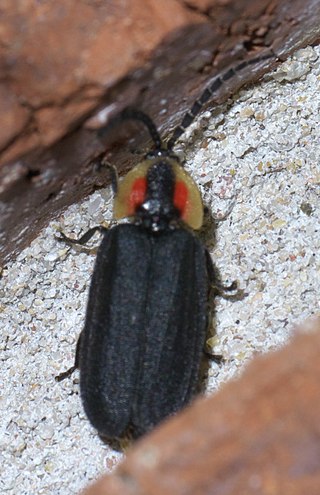
The Lampyridae are a family of elateroid beetles with more than 2,000 described species, many of which are light-emitting. They are soft-bodied beetles commonly called fireflies, lightning bugs, or glowworms for their conspicuous production of light, mainly during twilight, to attract mates. Light production in the Lampyridae is thought to have originated as an honest warning signal that the larvae were distasteful; this was co-opted as a mating signal in the adults. In a further development, female fireflies of the genus Photuris mimic the flash pattern of Photinus species to trap their males as prey.

The Elateroidea are a large superfamily of beetles. It contains the familiar click beetles, fireflies, and soldier beetles and their relatives. It consists of about 25,000 species.

The Photurinae are a subfamily of fireflies (Lampyridae). They contain many of the well-known North American species, such as the Pennsylvania firefly, state insect of Pennsylvania. They are among the "flashing" fireflies known as "lightning bugs" in North America, although they are not too distantly related to the flashing fireflies in the Lampyrinae; as the most basal lineages of that subfamily do not produce light at all, the Photurinae's flashing signals seem to be convergent evolution.

Photinus carolinus is a species of rover firefly whose mating displays of synchronous flashing have fascinated both scientists and tourists. As individual females synchronize with males nearby, waves of alternating bright light and darkness seem to travel across the landscape. Firefly displays typically occur in early June near Elkmont, Tennessee, in the Great Smoky Mountains National Park, near Gatlinburg.
Pyractomena punctiventris is a species in the family Lampyridae (fireflies), in the order Coleoptera (beetles). It is found in North America, where it is known from east-central Texas south to Veracruz, Mexico.

Pyractomena is a genus of fireflies in the family Lampyridae. There are at least 20 described species in Pyractomena.

Aspisoma ignitum is a species of firefly in the family Lampyridae. It is found in the Caribbean, Central America, North America, and South America. Its presence is uncertain in the United States.
Micronaspis is a genus of fireflies in the family of beetles known as Lampyridae, containing only one species, the Florida intertidal firefly. It is found in the Bahamas and Florida. It is threatened by habitat loss from coastal development as well as storm surges and sea level rise as a consequence of climate change, with Hurricane Dorian having a major impact on Grand Bahama island, where the species is known from. Increased chemical and light pollution has also seriously affected the species. Further threatening it in Florida is the introduction of Steinernema carpocapsae as a biocontrol agent for crops, which is known to target other beetle species than the ones it is meant to control; it is likely the cause of a local extirpation of a population of M. floridana from Sarasota Bay.

Lucidota atra, the black firefly or woodland lucy, is a diurnal species of firefly — a member of the Lampyridae family of beetles.

Pyractomena lucifera is a species of firefly in the beetle family Lampyridae. It is found in North America.
Photuris fairchildi is a species of firefly in the beetle family Lampyridae. It is found in North America.This species is known to use aggressive mimicry in order to lure in and prey upon the males of other species of fireflies. This species inhabits marshes, spruce forests, and other low-lying swampy areas.
Pyractomena vexillaria is a species of firefly in the beetle family Lampyridae. It is found in Central America and North America.
Pyractomena ecostata, the keel-necked firefly, is an endangered species of firefly in the beetle family Lampyridae.

Pyractomena angulata is a species of firefly in the family of beetles known as Lampyridae. It is found in North America and is the state insect of Indiana. It is also known as Say's firefly named after Thomas Say, and the angle candled firefly.
Pyractomena dispersa is a species of firefly in the beetle family Lampyridae. It is found in North America.
Pleotomus pallens is a species of firefly in the beetle family Lampyridae. It is found in Central America and North America. The female firefly of this species emits a brighter form of light than the male and this light decreases after she lays eggs; after she has performed this duty, she dies.
Photinus indictus, or silent firefly, is a species of firefly in the beetle family Lampyridae. It is a diurnal firefly, active during the day rather than at night, with no lanterns. It is found in eastern North America.
Pyractomena linearis is a species of firefly in the beetle family Lampyridae. It is found in North America.
Pterotus is a genus of fireflies in the beetle family Lampyridae. There are at least two described species in Pterotus.
Pyractomena marginalis is a species of firefly in the beetle family Lampyridae. It is found in North America.








